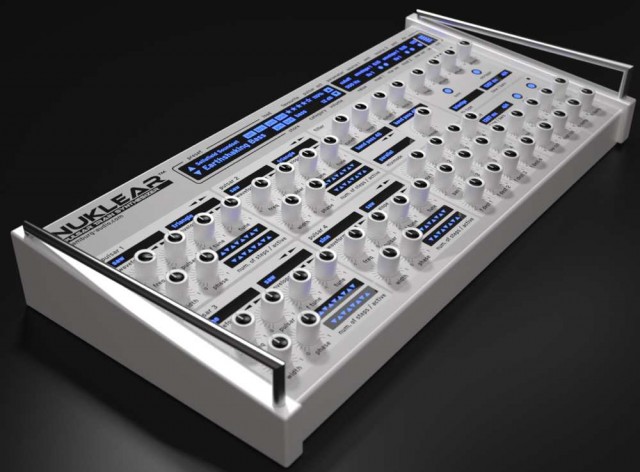
Hamburg Audio has released Nuklear, described as the first plugin synthesizer based on “advanced pulsar synthesis”.
Here’s what they have to say about advanced pulsar synthesis:
Nuklear comes with unique pulsar oscillators and enriches classic sound synthesis with essential new parameters: by disassociating the note pitch from the waveform length it is possible to create new, previously unheard sounds.
As opposed to classic sound synthesis not the waveform length, but solely its repetition rate is responsible for the resulting pitch. The length of the individual “pulsaret grains” is controlled and modulated by a separate parameter, the “pulsaret frequency”.
Unfortunately, there don’t seem to be any audio demos of Nuklear & its advanced pulsar synthesis on the company’s site. Maybe they were too busy making gratuitously sexy 3D graphics of their software synth, like the one above, to be able to make some audio demos.
We hope that they will fix that, so that those ” new, previously unheard sounds” won’t remain unheard.
Features:
- Advanced pulsar synthesis with 4 pulsar train generators and up to 16 voices.
- 26 pulsar waveforms and 4 pulsar envelope waveforms.
- 8 low frequency oscillators.
- 8 ADSHR envelope.
- Built-in delay effect with sync option.
- Built-in distortion effect with 3 distortion types.
- 16-step sequencer with 8 programmable patterns for note and multiple parameter modulation control.
The plugin is available in Audio Unit, VST2 and VST3 format for Windows (32bit & 64bit) and Mac (Intel) for 169 Euro.
via rekkerd

It’s fuckin hilarious to see these pictures of things that don’t actualy physically exist
What a load of shit!!!
Haha. It’s a long running past time on this site to laugh at/be irked at these ridiculous 3d renders. I mean why do they even bother?
It does seem strange, in this day and age, that they have no audio demos linked on the site. But then they do have the demo version as a free download for the curious. As much as I am over software synths I have to admit that I am curious to see if it is something really new.
All sounds like bollocks to me. Pitch is always associated with ‘repetition rate’, not ‘waveform length’ (whatever that is).
there is a preview video of the alpha version available (german only)
http://www.musotalk.de/software/video/article/hamburg-audio-nuklear-software-synthesizer/
So true, but then again, maybe they had already developed the 3D artwork to create the interface (for the front of the interface just render an orthographic view with lighting), so just giving it a nice “box” and an isometric view wasn’t that big of a leap.
Well we were all just speculating. I just downloaded the demo and gave it a brief going over. I can’t really say that any of the presets jumped out at me like something that I had never heard before. But this program has tons of character. If I was going to compare it to anything in my experience it would be a DSI Evolver. There is a sequencer hidden behind the effects section. There are 4 oscillators with 26 waveforms each. There are 8 envelopes and 8 LFOs. All of the controls are easy to get to once you understand that some things are hidden behind other things. The LFOs are behind the envelope panel for example.
The presets are a mix of your usual fat basses, screaming leads, etherial pads and Forbidden Planet FX patches. It was in this last category that I found things most to my liking. There are some very distinctive sounds to be found here. I think that if you spent some time tweaking this thing you would be surprised at what you can do with it.
Rather than beat the guy down for the 3D drawing of the control panel, I think we should give him some kudos for at least trying to do something a bit different. Or maybe at least try it out before we pronounce his work as shit? I found much to like here.
That’s one pronouncement we didn’t make – but they need some audio demos if they want people to try this out.
This pulsar stuff might sound like nonsense if you’ve never heard of it before. However, it’s not new. You can Curtis Roads’ paper on it here:
http://clang.mat.ucsb.edu/articles_files/SoundCompwithPulsars.pdf
The manual for Nuklear also quotes from that paper.
http://www.hamburg-audio.com/NUKLEAR_GB.pdf
it can’t be that far off using pulse waves on a analogue modelled soft synth.
Hello, calm please, the projects are in the fantasy first.